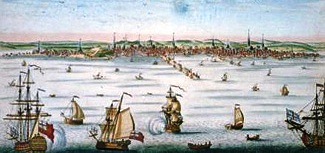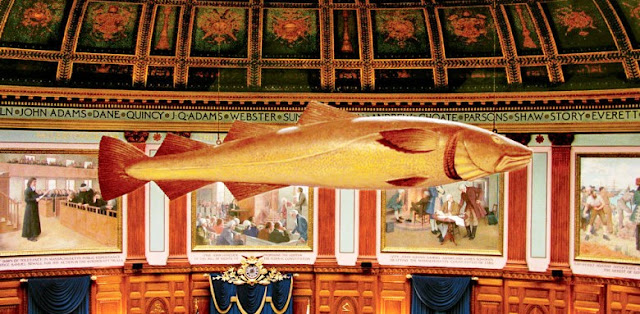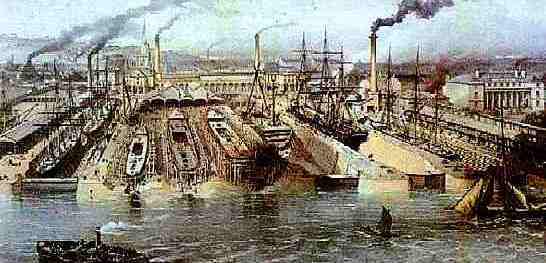
The New England Colonies were decidedly different from those of the Southern Colonies not only in their animating ideals but also in their methods of settlement and expansion. Although the organizers of the Puritan migration believed that political responsibility should belong to a small ruling group, they established economic institutions which promoted an attitude of equality.
Thus New England became more democratic than the South. It was also less individualistic, retaining much of that collective spirit which had been characteristic of the medieval village community. Having rocky soil, farming in New England Colonies was not as productive as Southern or Middle Colonies.
Economy of New England Colonies
New England Agriculture and Land Holding
Earliest New England Colonies usually had fishing villages or farming communities on the more fertile land along the rivers. Although the soil was not fit for large plantation of cash crops such as wheat, rice, tobacco, sugarcane etc., the basic necessity of the colonists was fulfilled. But farmers could produce various types of vegetables in abundant.
Land was granted by the colonial governments not to separate individuals but to towns. A group of people would obtain permission to establish a new town. Having acquired land, would divide part of it into separate farms and keep the remainder for collective use or for distribution later when the population increased.
Each member of the group became a freeholder and had no rent obligations. Local government and control of the common lands were initially vested in the town meeting, in which all freeholders had voting rights.
This system was not wholly equalitarian, since of persons of greater wealth and social prestige received larger farms. But there were no sharp class distinctions. All the houses in the town were usually built around a central plot of common land, instead of being scattered over the countryside. So, all the inhabitants were definitely members of a single community and had to confront to accepted mores and beliefs.
Although the church members constituted an elite group in that they alone could be enfranchised, this political right did not carry economic privileges with it. And a foundation for democracy was established in the land system and the town meeting.Economy of New England Colonies
New England Trade and Industry
Since soil was not fertile, the more ambitious and enterprising of the New Englanders turned towards the sea. Due to the presence of New England Colonies along the Atlantic coast, there was an abundance of marketable sea life.

Though there was lack of fertile soil, the land provided other natural resources, such as wildlife and lumber. So, hunting wildlife for fur and meat became another major economic activity, in addition to fishing. Because, there was a shortage of wood, the colonist could export lumber.
Shipbuilding, the most important industry of New England began as early as 1631, when craftsmen built a 30 ton vessel for Governor Winthrop. Before long, the New England colonies took their final shapes; Massachusetts was constructing ships not only for its own merchants but also from sale abroad.
Boston, gradually emerging as one of the major shipbuilding center of the contemporary world, quickly developed commercial interests with other parts of the world, particularly with the Caribbean. New England colonists had created an Atlantic trade network that connected them to the English homeland as well as to the West African Slave Coast, Iberian Peninsula along with the Caribbean's plantation islands by the end of the 17th century.
New England colonists relied upon British and European imports for glass, linens, hardware, machinery, and other items for the household; whereas they could not offer much to England beyond fish, furs, and lumber. So, inflation was a major economic issue during its early period.
But relying upon abundant lumber, shipbuilding revived the economy to a great extent during 18th century; the industry was often under the direction of the British Crown.
Economy of New England Colonies
New England Colonies Towns
From the very beginning New England colonists were fond of living in close democratic townships. But it was the limitation to access easy economic activity, which enhanced the process of urbanization in the New England colonies.
Economy of New England Colonies
Conclusion
Since New England produced little which could be sold in Europe, its capacity to buy manufactured goods was limited. This stimulated growth of local industries. Most farm families produced at home almost everything they needed, thus becoming independent of the market except for a few raw materials an occasional luxury. The farmer constructed his own house along with own tools and furniture, and his wife made the clothing and preserved food for winter.
But there were a number of professional craftsmen, some of them migratory and others established in the larger towns. They engaged in such occupations as weaving, carpentry, shoemaking, hat making and the manufacture of silverware and pottery. As in medieval England, the prosperous craftsmen gave employment to apprentices and wage earners. But their employees normally expected to become independent after they had acquired enough experience.
Among all of the colonies, New England colonies were the poorest. But exporting fur, timber, rum, fish and a number of different foodstuffs especially to West Indies, Boston ship-owners also acquired a considerable carrying trade. By the later decades of the 17th century a number of merchants had acquired considerable fortunes.
Thus, except on the seacoast, early New England became a country of small farmers. They carried on a diversified agriculture primarily for their own subsistence. There was no basic cash crops, no big plantation and of course, no large servant class. But a strong foundation for manufacturing and industry had been developing for the generations to come.
ALSO CLICK:-
Economy of New England Colonies Sources:
- Perkins E.J (1983), The Economy of Colonial America.
- Andrews C.M. (1934-37), The Colonial Period in American History.
- Steeg C.L.V. (1964), The Formative Years.
- Adams J.T. (1921), The Founding of New England.
- Morison S.E. (1930), Builders of the Bay Colony.
- Bolton H.E and Marshall T.M. (2015), The Colonization of North America 1492-1783.
Comments
Post a Comment